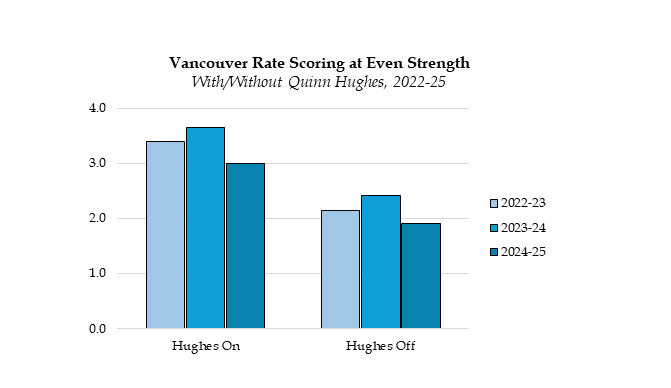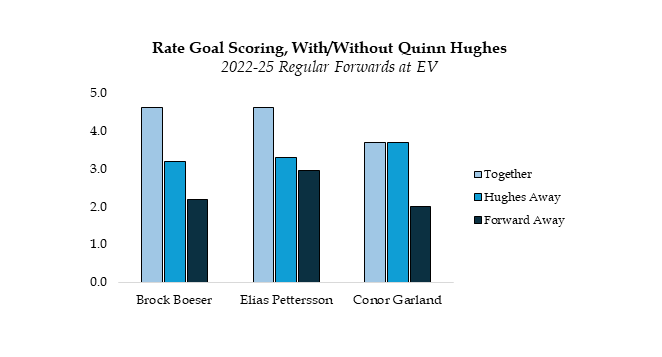5h ago
Canucks’ path to the playoffs starts with offensive balance
The Vancouver Canucks are ready to prove last year’s disappointing 90-point season was an outlier, writes TSN's Travis Yost.
By Travis Yost
The Vancouver Canucks are ready to prove last year’s disappointing 90-point season was an outlier.
But they won’t simply need better injury luck to return to the promised land of the Stanley Cup Playoffs. The Canucks need a considerable rebound in offensive production, one that isn’t so reliant on superstar defenceman Quinn Hughes.
After the big J.T. Miller trade with the Rangers last season, Vancouver shifted their focus to securing the major pieces of their roster, extending Brock Boeser, Conor Garland, and Thatcher Demko this off-season. The Canucks still may be on the hunt for another centre with Miller’s loss, but they did address at least one of their vacant wing positions, adding Evander Kane through a trade with the Edmonton Oilers.
The hope is that the injury misfortune from a season ago abates into next year, and that the core parts of this roster are still good enough to push into the playoffs.
It’s worth highlighting just how notable the injury bug was last season. Demko didn’t start playing until mid-December, Boeser and Filip Chytil both dealt with concussions, Elias Pettersson missed time late in the year due to an oblique injury, and their top defensive pairing of Hughes and Filip Hronek combined to miss 35 games. If you don’t have elite depth, overcoming injuries of this magnitude can be difficult.
The lengthy off-season surely has brought Vancouver back to full health, but I do think a key question remains with this team, and that’s whether they have the personnel to create enough offence in the minutes without Hughes. It’s been a problem for a few years now, and I would argue it was an outsized issue during the 2024-25 season.
Vancouver finished the year 24th in even-strength scoring, but they’re in some respects lucky they finished ahead of eight other teams. The below three-year graph shows just how much the Canucks have struggled to generate offence when their top pairing is sidelined:

Top pairings (and top lines) are expected to outperform the rest of the lineup; the issue is not about that relationship, but how significant the drop off is between the two.
For baselining purposes, Vancouver’s rate scoring over the past three seasons with Hughes deployed is comparable to that of is comparable to that of Dallas’ with Mikko Rantanen on the ice, or Toronto previously with Mitch Marner on the ice. The problem is that when Hughes comes off the ice, Vancouver is barely scoring 2.0 goals per 60 minutes. That’s less than what the Nashville Predators averaged a season ago, and they finished as the league’s weakest offence.
Hughes is a dynamic playmaker who can ignite offence from the back end on any shift, and what he brings to the ice benefits every forward in the Vancouver lineup. But again, therein lies the problem – when players like Pettersson, Boeser, and Garland play with Hughes, they are an absolute force. When they don’t play with the Hughes pairing, their scoring suffers dramatically:

Vancouver’s bottom-nine forwards certainly need to pull their own weight, but when you see strong individual scorers like Boeser and Pettersson struggle to generate offence without Hughes, you start to wonder how much of an adverse influence the Canucks’ bottom-four defencemen are having.
To that end, I do wonder what new head coach Adam Foote makes of his bottom-four defenders and their ability to take on more of a two-way burden.
Vancouver is set to dress some combination of Derek Forbort, Tyler Myers, Marcus Pettersson, and 21-year-old Elias Pettersson behind the Hughes pairing. It goes without saying there is rather limited offensive skill within this group, which is either going to place more of a burden on Vancouver to dominate their top-line and top-pairing minutes, or necessitate major goaltending outperformance to return to the playoffs.
But if the Canucks can find just a bit more offensive balance we may be talking about a genuine playoff threat, versus a fringe playoff contender.
Data via Natural Stat Trick, NHL.com, Evolving Hockey.

